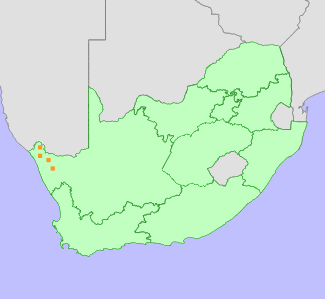|
Scientific Name | Ruschia brevifolia L.Bolus |
Higher Classification | Dicotyledons |
Family | AIZOACEAE |
National Status |
Status and Criteria | Vulnerable A2ac+4c |
Assessment Date | 2022/11/29 |
Assessor(s) | D. Raimondo & P.C.V. Van Wyk |
Justification | A restricted range species that was formerly common and one of the dominant species within its range. It has experienced a 30% population decline over the past 20 years (1 generation) due to drought attributed to climate change. Ongoing loss of a further 15-20% of the population is likely within the next two generations (40 years). It therefore qualifies for listing as Vulnerable under criterion A. |
Distribution |
Endemism | South African endemic |
Provincial distribution | Northern Cape |
Range | This species is endemic to the northern Namaqualand region of South Africa where it occurs between Richtersveld and Springbok. |
Habitat and Ecology |
Major system | Terrestrial |
Major habitats | Succulent Karoo |
Description | It grows on migmatite and gneiss derived soils. |
Threats |
| The population has experienced extensive mortality as a result of the most severe drought on record. Its entire range has experienced below average rainfall since 2012. Predictions of future climate change include further increases in annual average temperature of between 1.4°C and 2.4°C by 2050, which will result in unbearably hot temperatures and ongoing aridification throughout significant portions of the year (Van Wilgen et al. 2017). |
Population |
This is a common and dominant species in suitable habitat. However the population has declined by at least 30% since 1992 due to drought related mortality. While this species recruits easily with only a little rainfall and is expected to have some recovery, a further 15 -20% decline as a result of ongoing aridification in the region is likely by the year 2062.
|
Population trend | Decreasing |
Assessment History |
Taxon assessed |
Status and Criteria |
Citation/Red List version | | Ruschia brevifolia L.Bolus | Data Deficient (Taxonomically Problematic) | Raimondo et al. (2009) | |
Bibliography |
Raimondo, D., von Staden, L., Foden, W., Victor, J.E., Helme, N.A., Turner, R.C., Kamundi, D.A. and Manyama, P.A. 2009. Red List of South African Plants. Strelitzia 25. South African National Biodiversity Institute, Pretoria.
Snijman, D.A. 2013. Plants of the Greater Cape Floristic Region 2: The extra Cape flora. Strelitzia 30. South African National Biodiversity Institute, Pretoria.
Van Wilgen, N.J. and Herbst, M. 2017. Taking stock of parks in a changing world: The SANParks Global Environmental Change Assessment. SANParks, Cape Town.
|
Citation |
| Raimondo, D. & Van Wyk, P.C.V. 2022. Ruschia brevifolia L.Bolus. National Assessment: Red List of South African Plants version 2024.1. Accessed on 2025/11/08 |
 Comment on this assessment
Comment on this assessment


